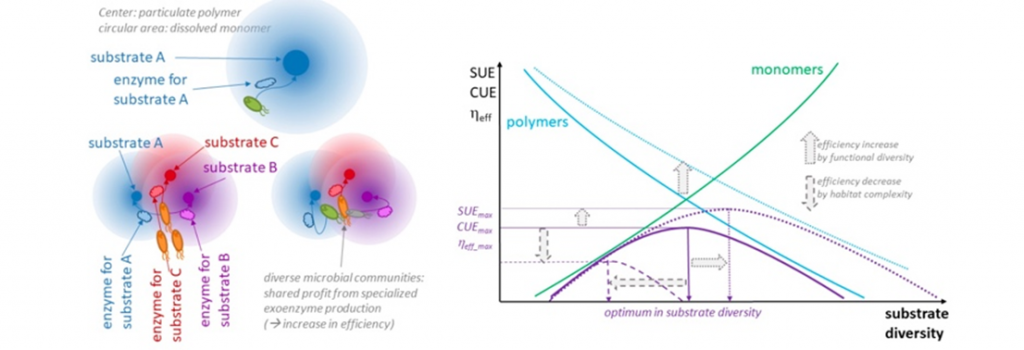Economic and bioenergetic controls on microbial metabolism of complex substrates in soils

The fundamental channels of matter and energy in soils are the reactions of microbial metabolism, which conform to thermodynamic principles such as negative Gibbs free energy change. Consequently, catabolic exergonic reactions are needed to fuel the energy-demanding reactions of biomass synthesis in addition to extracellular enzymes to access substrates. Therefore, bioenergetic and cell economic principles will underlie the thermodynamic-metabolic approach developed by EcoEnergeticS. We aim at understanding microbial use of simple and complex substrates in soils by characterizing five proxies of microbial efficiency: 1) substrate use efficiency, 2) carbon use efficiency, 3) biochemical efficiency, 4) calorespirometric ratio, and 5) thermodynamic efficiency. We expect a trade-off between the efficiency of biomass growth on diverse monomeric precursors that require little metabolic conversion, and the inefficiencies of producing complex enzyme systems to liberate these monomers from diverse polymers. We therefore hypothesize an optimum of microbial efficiency at intermediate substrate complexity, modulated by the cooperative functional diversity of microbial communities and their soil habitats’ boundary conditions. By extension, we hypothesize that the complexity of microbial necromass accounts for its entombing in SoilSystems.
In WP1, we implement thermodynamic constraints in soil metabolic flux analysis (MFA) to analyze and model microbial growth on chemically diverse substrates entering central C metabolism at different levels. The impact of monomer diversity on microbial growth and use efficiencies will be quantified in WP2, considering the advantages of precursor ratios that meet the demand of biosynthetic pathways for cell replication. WP3 investigates an alternative substrate use – storage compound formation – as an energy storing strategy under energetically unfavorable growth conditions. In WP4 we shed light on the additional costs of exoenzyme production arising from the predominance of polymers as C sources in soils, using MFA and enzyme economic approaches. Cooperative energy gains by “exoenzyme sharing” among functionally diverse microbial communities will be targeted in WP5. WP6 implements spatio-temporal boundary conditions of microbial habitats as crucial factors of exoenzyme economics, coupling the bioenergetic dimension of substrate use to the joint experiment on various levels of soil complexity as predictors of matter and energy-use channels.
Summarizing, a systems-ecology-based bioenergetic concept on substrate use and channeling in soils will be developed, resolving matter and energy fluxes down to the level of biochemical pathways. Thermodynamic constraints of microbial metabolism will be linked with resource economy, considering complex factors of habitat boundary conditions in soils. Thus, this project will provide a unifying concept of bioenergetics and resource economics to SoilSystems.
Link to English scientific abstract
Link to German scientific abstract